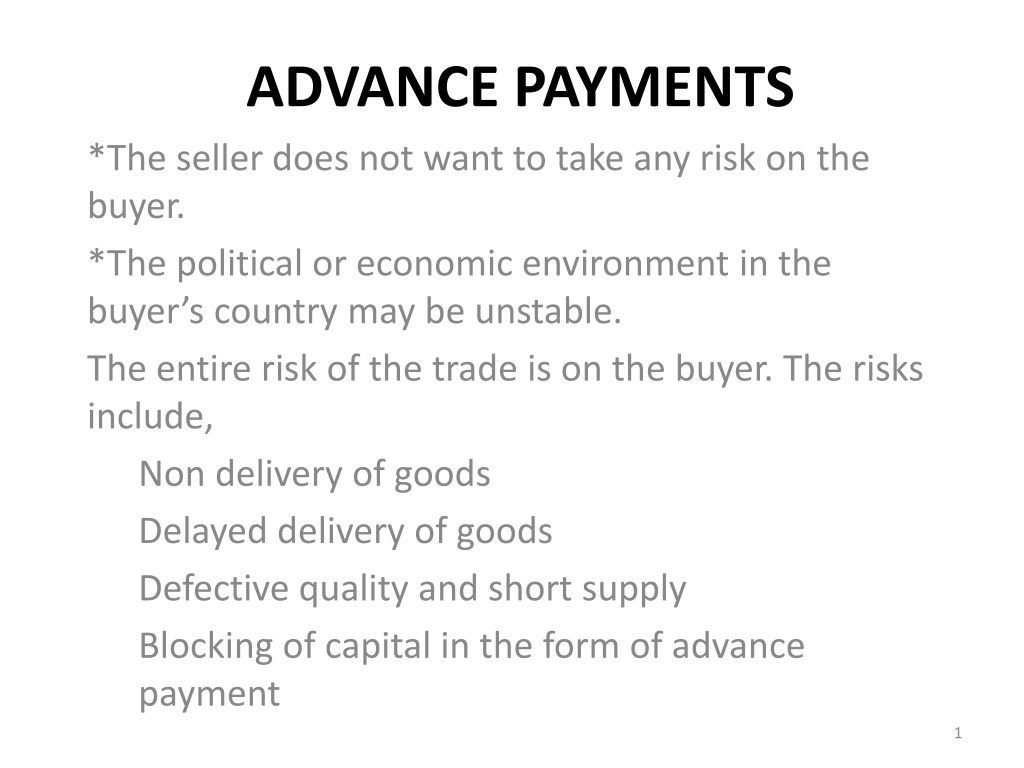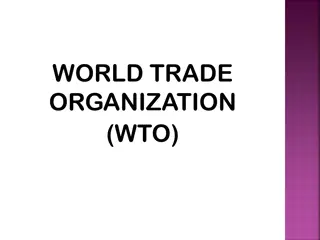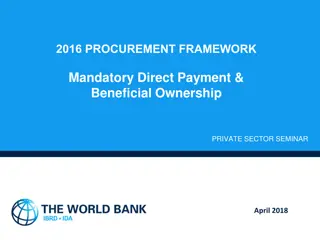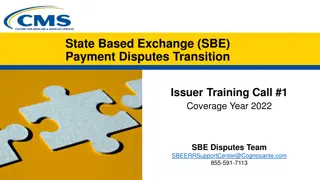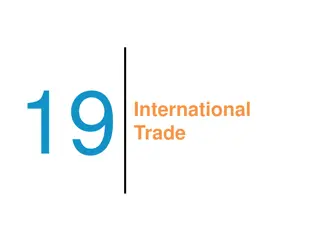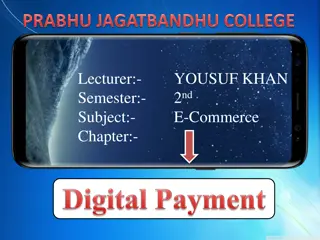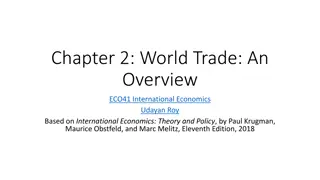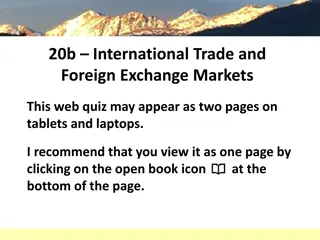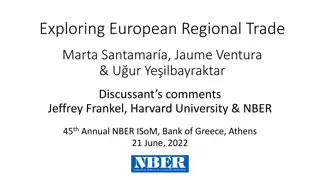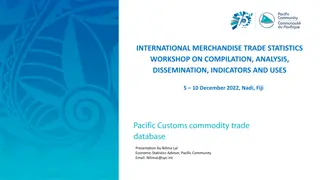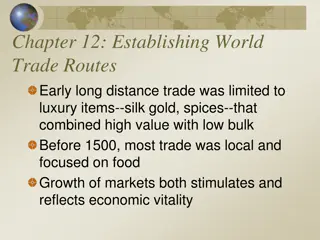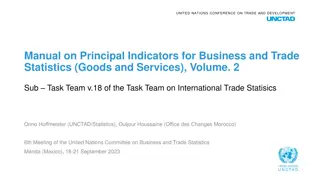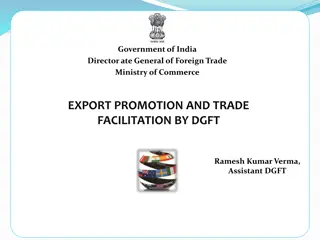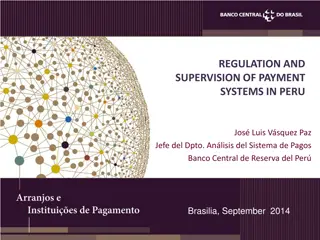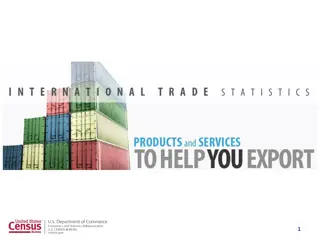International Trade Payment Methods & Risks Explained
Different payment methods in international trade including advance payments, open accounts, and documents through bank are discussed along with their associated risks and processes. These methods involve varying degrees of risk allocation between buyers and sellers, with implications for trust, financial security, and document handling. The images illustrate the key points of each payment method.
Download Presentation

Please find below an Image/Link to download the presentation.
The content on the website is provided AS IS for your information and personal use only. It may not be sold, licensed, or shared on other websites without obtaining consent from the author. Download presentation by click this link. If you encounter any issues during the download, it is possible that the publisher has removed the file from their server.
E N D
Presentation Transcript
ADVANCE PAYMENTS *The seller does not want to take any risk on the buyer. *The political or economic environment in the buyer s country may be unstable. The entire risk of the trade is on the buyer. The risks include, Non delivery of goods Delayed delivery of goods Defective quality and short supply Blocking of capital in the form of advance payment 1
OPEN ACCOUNTS SALES By an arrangement between the buyer and the supplier, manufactured goods will be delivered to the buyer directly or to his order and the buyer will pay at the end of the agreed period. This type of payment term requires high degree of trust by the seller on the buyer. In case of International trade transaction the buyer after receipt of goods submits to his bank the documents along with proof of receipt of goods (Bill of Entry) issued by the customs department and arranges for the funds to be transferred to the seller s account abroad. 2
DOCUMENTS THROUGH BANK Against payment i.e. DP After the sale contract is entered into, the seller dispatches the goods and prepares the various documents as required by the buyer and submits the same to his bank with instructions to send the same to the buyer s bank. The documents include the transport document, commercial invoice, insurance document and (most of the times) a Bill of Exchange 3
The seller instructs his bank to advise the buyer s bank to hand over the documents to the buyer only against payment of the specified amount. (under this method there is no credit period involved 4
On receipt of the documents the buyers bank informs the buyer about the arrival of the documents and advises him to pay the invoice amount and take delivery of the documents 5
After the buyer makes payment, the buyer s bank hands over the documents with necessary endorsements. The bill of exchange is also handed to the buyer acknowledging receipt of the payment 6
The funds are then remitted to the sellers bank for onward payment to the seller. The buyer takes delivery of the goods from the shipping agency/transport agency/airline, as the case may be, by producing the duly discharged transport document 7
In the event of non -payment by the buyer the bank informs the seller s bank accordingly and seeks instructions regarding disposal of the documents 8
If the bill continues to be unpaid, the buyer s bank will return the documents to the seller s bank from whom the documents have been received 9
DOCUMENTS AGAINST ACCEPTANCE In this method, the seller is ready to take an exposure on the buyer and is willing to sell the goods to the buyer and extend credit. This is akin to an open account transaction except that the documents are routed through the bank. Thus the buyer s bank is instructed to hand over the documents to the buyer against his acceptance to pay the amount on the specified due date Accordingly, the buyer s bank obtains the buyer s signature on the bill of exchange accepting that the bill will be paid on the due date. The documents are then handed over to the buyer against his acceptance. The buyer pays the amount to the bank on the due date. The buyer s bank remits these funds to the seller s bank. 10
DOCUMENTS THROUGH BANK UNDER LETTER OF CREDIT There are many situations where the seller may not know the credit worthiness of the buyer and does not want to take any risk on the buyer. At the same time the buyer may not be willing to pay the amount in advance. However both the parties wish to conclude the trade. The seller would like to have some kind of a guarantee or commitment from the buyer s bank that the bill will be paid by the bank whether the buyer pays or not. The bank opens a letter of credit in favour of the seller undertakes to pay the seller the bill amount provided the stipulated documents are submitted by the seller. Thus, the risk of non-payment by the buyer gets mitigated through the letter of credit and the trade gets concluded. 11
A LETTER OF CREDIT CAN BE DEFINED AS Any arrangement, however named or described whereby a bank acting at the request and on the instructions of a customer or its own behalf, Undertakes to make a payment to or to the order of a third party (i.e. the seller) or undertakes to accept and pay Bill of Exchange drawn by the Beneficiary, Or Authorizes another bank to effect such payment or to accept and pay such bills of exchange, against the stipulated documents provided that the terms and conditions of the credit are complied with . 12
ARTICLE 2 OF UCP 600 DEFINES LC AS Any arrangement, however named or described, that is irrevocable and thereby constitutes a definite undertaking of the issuing bank to honor a complying presentation . 13
ESSENCE OF A LETTER OF CREDIT The bank issuing the Letter of Credit gives an undertaking to the seller/supplier (beneficiary) of the goods or services to pay a certain amount. The undertaking is irrevocable and is normally given on behalf of the buyer who will be the bank s client. This undertaking is conditional, the condition being that the beneficiary has to submit the documents as prescribed in the Letter of Credit. The issuance of the Letter of Credit has to be backed by a trade transaction. The Letter of Credit confers certain rights on the beneficiary of the LC. 14
The beneficiary of the LC becomes entitled for his right (of getting paid by the bank) only if he submits documents which are in conformity with the LC conditions. Banks deal with documents and not in goods, services or performance to which the documents may relate. Under the LC mechanism, the beneficiary of an LC cannot be compelled to perform under the LC. If he so chooses he is free not to utilize the LC. A credit by its nature is a separate transaction from the sale or other contract on which it may be based. Banks are in no way concerned with or bound by such contract, even if any reference to it is included in the credit. 15
CASH COLLATERALS Suppose the LC limit is Rs 100lakhs and the margin is 25%, the customer can choose to keep a fixed deposit of Rs 25lakhs which will be under lien to the bank. When the bill under LC is received the customer pays the full amount of the bill and retires the bill. The fixed deposit remains intact and will earn interest as applicable to FD s. The advantage here is the customer can continue to open LCs up to Rs 100lakhs and save himself from the botheration of depositing margin money every time an LC is opened. This method is simpler from the accounting angle also. Most of the corporate that regularly open LC s follow this method OR the customer can chose to deposit 25% of the LC amount every time an LC is opened. Suppose the LC limit is Rs 100lakhs and an LC has to be opened for Rs 30lakhs with a margin of 25% the customer has to deposit Rs 7.5lakhs in a margin account or in a short term deposit account. When the bill for Rs 30lakhs is received under the LC the customer has to pay Rs 22.5lakhs only. The bank will adjust the balance from the margin money which is already with the bank 16
Specimen of a Bill of Exchange (Usance DA basis) drawn under a Letter of Credit - --------------------------------------------------------------------------------------------------------------------------------- BILL OF EXCHANGE NO. 10165 For JY9,000,000. - Nagoya 25th February, 2012 and date being unpaid) Pay to THE CHUKYA BANK LIMITED or order the sum of At 180 days from bill of Lading Date of this SECOND Bill of Exchange (First of the same tenor JAPANESE YEN NINE MILLION Only Value received and charge the same to account of XYZ, Shed No 4, Nadandyakama Halli, Tumkur Road, Bangalore 562 123, India Drawn under Citibank N.A. Bangalore Branch, Bangalore, India L/C No 5576131508 dated 5th January 2012 TO Citibank N.A TRADING COMPANY BANGALORE, INDIA N. Nakiima B/L Date: 25th February 2012 ---------------------------------------------------------------------------------------------------------------------- UNITY (Managing Director) 17
A B/E PERFORMS FOLLOWING FUNCTIONS Collecting Payment Demanding Payment Extending Credit Promise of payment Receipt for payment 18
COMMERCIAL DOCUMENTS Commercial Invoice Consular Invoice Custom s Invoice Legalized Invoice Certificate of Origin Packing List Weight Certificate Certificate of Analysis and Quality Certificate of Inspection Health Certificate 19
AIRWAY BILL Airway Bill (AWB) is an acknowledgement issued by an airline company or their agents stating that they have received the goods detailed therein for dispatch by air to the named consignee and the address stated therein. Unlike a Bill of Lading, AWB is not a document of title to goods because it is merely an acknowledgement of goods. As such it is not a negotiable document either. Consequently, it is not necessary for a consignee to possess the AWB for taking delivery of goods. The airlines will normally deliver the goods to the consignee or his order on proper identification. 20
HOUSE AIRWAY BILL House Airway Bill is a receipt for goods issued on the same lines as Airway Bill by cargo consolidating agents. When Air cargo is shipped under consolidation, the Airline company issues an Airway Bill called Master Airway Bill to the consolidating cargo agent and he is turn issues his own House Airway Bills to individual shippers. Thus, House Airway Bill is a receipt for goods issued not by the actual carriers or their agents but an intermediary cargo consolidating agent. A House Airway Bill is not as safe a document as an Airway Bill. In case the consolidating agent fails to pay the freight, the carriers will have the right over the goods and the holder of House Airway Bill will not get his goods. 21
MULTIMODAL TRANSPORT DOCUMENT This document is issued when the movement of goods involves more than one mode of transport. It is also called as Combined Transport Documents . In this document the carriers take the liability for safe conduct of transport of goods by various modes of transport from the place of receipt of goods to the place of delivery. In most respects it has the characteristics of a Bill of Lading. 22
LORRY RECEIPTS AND RAILWAY RECEIPTS The transport operator/railway department issues receipts evidencing receipt of goods and undertaking to transport the goods to the specified destination. The surrender of LR s or RR s is required for taking delivery of goods at the destination. These receipts are documents of title to goods and considered as Quasi Negotiable instruments. 23
PARTIES TO LETTER OF CREDIT TRANSACTION Applicant Beneficiary Issuing bank Advisingbank Nominated bank Confirming bank Negotiating bank Reimbursing bank 24
OPERATION OF A LETTER OF CREDIT Stage 1: Establishing and advising a letter of credit Stage 2: Negotiation and payment of documents under a letter of credit 25
ESTABLISHING A LETTER OF CREDIT Buyer and seller conclude a contract of sale. Buyer submits LC application to his bank along with a copy of a sales contract or proforma invoice or purchase order Issuing bank issues a Letter of Credit and sends it to the advising bank in the city/country of the beneficiary. The LC is sent by SWIFT to the advising bank The advising bank on receipt of SWIFT message advises the LC to the beneficiary by sending a signed hard copy of the Letter of Credit authenticating the genuineness of the credit 26
NEGOTIATION AND PAYMENT OF DOCUMENT UNDER LETTER OF CREDIT After shipping the goods in accordance with the LC terms, the beneficiary receives the transport documents evidencing the shipment of goods Beneficiary submits documents under the LC to a negotiating bank (or confirming bank). After examining the documents and if found in conformity with credit terms, negotiating bank (or confirming bank) effects payment to the beneficiary 27
If there are discrepancies in the document the negotiating bank may still make payment to the beneficiary say under reserve etc (this depends on the arrangement the exporter has with the bank). Negotiating bank then forwards documents to LC issuing bank (or confirming bank) claiming the amount under UCP 600. 28
On receipt of documents the LC opening bank examines the documents and decides whether to take up the document or to refuse the same. Simultaneously a DAN (Document Arrival Notice) is sent to the LC applicant notifying discrepancies, if any If the documents are in order, the LC issuing bank remits the money to the negotiating bank and recovers the amount from the LC applicant (If the LC applicant is unable or refuses to pay, the bank will pay from its own funds and charges it to the LC applicant s account). If the documents are discrepant, a discrepancy and refusal note is sent to the negotiating bank. 29
If the applicant accepts the discrepant bill and provides funds for the bill the LC opening bank remits the funds to the negotiating bank Original set of documents is delivered to the LC applicant duly endorsed in his favour by the issuing bank. Applicant submits these original documents to the clearing agent at the port of destination and obtains delivery of the goods. 30
FLOWCHART FOR PAYMENT UNDER USANCE LC S After shipping the goods in accordance with the LC terms, the beneficiary receives the transport documents evidencing the shipment of goods. Beneficiary submits documents under the LC to a negotiating bank (or confirming bank). After examining the documents and if found in conformity with credit terms, negotiating bank may affect payment to the beneficiary. Thereafter the documents are sent either to the confirming bank (if there is one) or to the LC issuing bank asking them to convey that the bills are accepted and that payment will be remitted to the negotiating bank on the due date. 31
On receipt of documents the confirming bank or the LC opening bank as the case may be examines the documents and decides whether to take up the document or to refuse the same. Simultaneously a DAN (Document Arrival Notice) is sent to the LC applicant notifying discrepancies, if any. If the documents are in order, a message conveying the acceptance of documents is sent to the negotiating bank. Thereafter the documents received under the LC are handed over to the LC applicant against his acceptance. On the due date the funds are remitted to the negotiating bank. The LC opening bank then recovers the funds from the LC applicants. (If the LC applicant is unable or refuses to pay, the bank will pay from its own funds and charges the amount to the LC applicant s account.) 32
If the documents are discrepant, a discrepancy or a refusal note is sent to the negotiating bank. The documents will be held with the LC opening bank at the disposal of the negotiating bank. If the discrepancies are accepted by the applicant the LC issuing bank sends an acceptance note to the negotiating bank confirming that the documents have been accepted and that the funds will be remitted on the due date. The documents are handed over to the LC applicant. On the due date funds are remitted to the negotiating bank (which may be say 60 or 90 days from the date of bill of lading). 33
DIFFERENT TYPES OF LETTER OF CREDIT Irrevocable LC As seen earlier this is a definite undertaking of the issuing bank and cannot be amended or cancelled without the agreement of the issuing bank, the confirming bank(if any) and the beneficiary (Article 7 & 8). It may be noted that a credit is irrevocable even if there is no indication to the effect on the LC (Article 3). 34
Confirmed LC A credit which has been confirmed by another bank (bank other than the issuing bank) is referred to as Confirmed Credit. In a confirmed credit, the beneficiary will have a firm undertaking of not only the bank issuing the credit, but also of another bank. Thus, there is a double undertaking in such credit and it is more favorable to the beneficiary. The bank which adds its confirmation is called a confirming bank. The beneficiary has following advantages in receiving a confirmed LC. 35
He has an additional guarantee of a bank in his country. Thus the credit and the other risks to which he is exposed get eliminated. The beneficiary can submit the documents to the confirming bank in his own city/country and get paid under the LC. This will save him all the hassles associated with dealing with the LC issuing bank which is located in another country. 36
Restricted Credit Means the credit issuing bank restricts negotiation of documents under their credit to a particular nominated bank. Beneficiary will be advised to negotiate the documents through this bank with whom credit is restricted. It should be noted that failure of the beneficiary to seek negotiation from the nominated bank does not affect the undertakings of the issuing bank and/or the confirming bank. In this event, the beneficiary is still entitled to claim payment from the issuing bank provided he submits complying documents to the issuing bank within the validity period of the LC. 37
TRANSFERABLE CREDIT In this type of an LC, the original beneficiary will be given the right to transfer the LC in favour of a second beneficiary or several second beneficiaries. Article 38 of UCP 600 deals with transferable credits. Some of the features of transferable credits are as under: An LC can be transferred only if it is specifically stated as Transferable in the credit. A credit can be transferred only once i.e. from first beneficiary to second beneficiary. (and not from second beneficiary to third beneficiary etc). A credit may be transferred in full or part to one or more second beneficiaries. The transferred credit must accurately reflect the terms and conditions of the credit with the exception of 1. Amount 2. Unit price 3. Expiry date 4. Period for presentation 5. Latest shipment date 38
OPERATION OF A TRANSFERABLE LC The first beneficiary submits his request in writing to the advising bank giving details of amount, name of second beneficiaries etc. The advising bank effects the transfer in favour of the second beneficiaries and issues fresh LC s with necessary changes. After the transfer is effected the details of transfer are informed by the advising bank to the LC opening bank The second beneficiary ships the goods and submits the documents along with the transferred LC to the advising bank The second beneficiary will get the payment from the advising bank if it is a negotiating bank or a confirming bank also. This payment will be made to the second beneficiary as per the stages involved in the flow chart indicated earlier. 39
REVOLVING LC Revolving credit is one where under the terms and conditions of the credit the amount is revived or reinstated without requiring specific amendment to the credit. The amount under the credit can revolve in relation to time or value. The basic principle of a revolving credit is that After a drawing is made, the credit reverts to its original amount for re-use by beneficiary. There are two types of revolving credits. In the first type of revolving credit, credit gets reinstated immediately after a drawing is made. In the second type of revolving credit, the credit reverts to original amount only after it is confirmed by the issuing bank (i.e. after the documents reach the issuing bank and it pays for the documents/or such fact is confirmed by the issuing bank). Revolving credits suit the requirements of importers and exporters when same material has to be imported/exported (say iron ore) at regular intervals for a specified period. 40
ILLUSTRATION An importer in India wants to import coking coal of value USD Three Million over a period of 12 months. His monthly requirement is of USD 250,000/-. The overseas supplier insists for entering into one year contract and also wants the transaction to be covered under Letter of Credit. Importers bank established a Letter of Credit for USD 250,000/- for a validity period of 12 months. At the same time, it is also specified in the credit that this credit will be available on monthly basis, twelve times during the validity period and the total utilization under this credit should not exceed USD 3,000,000/-. The advantage here is the importer need not open a fresh LC every month as USD 250,000/- gets reinstated soon after one consignment is shipped and documents pertaining to that shipment are paid under the LC. This saves a lot of botheration for the exporter also. 41
ILLUSTRATION An importer in India wants to import coking coal of value USD Three Million over a period of 12 months. His monthly requirement is of USD 250,000/-. The overseas supplier insists for entering into one year contract and also wants the transaction to be covered under Letter of Credit. Importers bank established a Letter of Credit for USD 250,000/- for a validity period of 12 months. At the same time, it is also specified in the credit that this credit will be available on monthly basis, twelve times during the validity period and the total utilization under this credit should not exceed USD 3,000,000/-. The advantage here is the importer need not open a fresh LC every month as USD 250,000/- gets reinstated soon after one consignment is shipped and documents pertaining to that shipment are paid under the LC. This saves a lot of botheration for the exporter also. 42
STANDBY LCS Standby Letter of Credit is very similar in nature to a bank guarantee. Standby LC differs with traditional LC. In a traditional LC the beneficiary is entitled for payment once he is able to submit the documents prescribed in the LC within the stipulated time. In Standby LC the beneficiary is eligible for payment from the issuing bank when the applicant fails to perform his obligation. The distinction between a standby credit and a commercial letter of credit can best be described as An irrevocable letter of credit is a payment mechanism for a trade transaction whereas an irrevocable standby letter of credit is merely a backup available to the beneficiary (from issuing bank) in case the applicant fails to pay or perform . 43
IN A STANDBY LC The issuer, usually a bank At the request of its customer, applicant Agrees that the beneficiary will be paid Before the credit s expiry Upon the beneficiary s presentment of: i. its demand for payment and ii. any documents evidencing the applicant s non- performance. This gives the applicant an opportunity to specify in the credit the documents that are to be presented by the beneficiary for claiming payment. 44
A SPECIMEN OF A STANDBY LETTER OF CREDIT We .. Bank hereby establish in favour of XYZ Ltd, Bangalore 02 (hereinafter called the Beneficiary ) our irrevocable standby letter of credit number (2528IGPER03209 dated 11.09.10 in the amount of Rs 2, 76, 00,000/- (Rupees Two Crores Seventy Six Lakhs only). Each payment made under standby credit of letter will be automatically reduced from the letter of credit amount. This standby letter of credit is available at our counter for payment unconditionally on first demand against presentation of the Beneficiary s signed drawing certificate dated and signed by two authorized signatories stating that the applicant has defaulted in the payment to yourselves. Partial drawings are permitted. The beneficiary may present any number of drawing certificates under this irrevocable standby letter of credit provided that our maximum aggregate liability hereunder shall not exceed Rs 2, 76, 00, 000/- (Rupees Two Crores Seventy Six Lakhs only). This standby letter of credit expires on 10.02.2011 at our counter. After this date, it will become automatically null and void and no claim will be taken into consideration. We undertake to cover your as per your instructions upon receipt of authenticated swift certifying that documents in full conformity with this standby letter of credit have been couriered to us. 45
OTHER TYPES OF LETTER OF CREDIT Payment Credit Payment Credit is a sight credit which will be paid at sight basis against presentation of requisite documents to the designated paying bank. In a payment credit, beneficiary may or may not be called upon to draw a draft (Bill of Exchange). Here credit issuing bank will provide reimbursement instructions in the credit itself and the negotiating bank may claim reimbursement simultaneously while forwarding the documents to the issuing bank. 46
Deferred Payment Credit Deferred Payment Credit is a usance credit where payment will be made by designated bank on respective due dates without the drawing of drafts. Acceptance Credit Acceptance Credit is similar to Deferred Payment Credit except for the fact that in this credit drawing of a usance draft is a must. Negotiation Credit Negotiation Credit can be a sight credit or a usance credit. Here the nominated bank can be a specific bank or it may allow free negotiation whereby any bank who is willing to negotiate can do so. 47
Restricted Credit Restricted Credit means the credit issuing bank restricts negotiation of documents under their credit to a particular nominated bank. Beneficiary will be advised to negotiate the documents through this bank with whom credit is restricted. Installment Credit calls for full value of goods to be shipped but stipulates that the shipments be made in specific quantities at stated periods of intervals. Article 32 of UCP deals with this. Reimbursement Credit Generally credits issued are denominated in the currency of either the applicant s country or the beneficiary s country but when a credit is issued in the currency of a third country it is referred to as Reimbursement Credit. Back to Back Credit When a second LC is issued on the basis of a parent credit the second credit will be termed as a Back to Back Credit . 48
Illustration Company A in Mumbai receives a LC for export of silk fabric. Company A does not manufacture but procures from party B in Mysore and exports in its own name. Party B requests company A to open an inland LC for supply of fabric. Company A approaches its bank and produces the export LC received by it and requests the bank to open the inland LC on almost similar terms and conditions of the parent LC. It offers the main LC issued in its favour as a security and promises the bank that it will be able to obtain payment by presenting the documents received under back to back credit. To some extent back to back credits serve the same practical purpose as that of transferable credits. This inland LC opened by company A in favour of party B is referred to Back to Back LC. 49
Costs of Non-cancellation of an LC for the LC opener - His LC Limit will continue to be blocked till the LC is cancelled and the liability reversed in the books of the issuing bank. The bank will not release the margin kept on the LC until the LC is cancelled. Possibility of losing the entire LC opening charges paid to the LC opening bank. As such, it is desirable for the buyer to take the initiative and have the LC cancelled as soon as he comes to know that the LC will not be utilized by the buyer. 50
